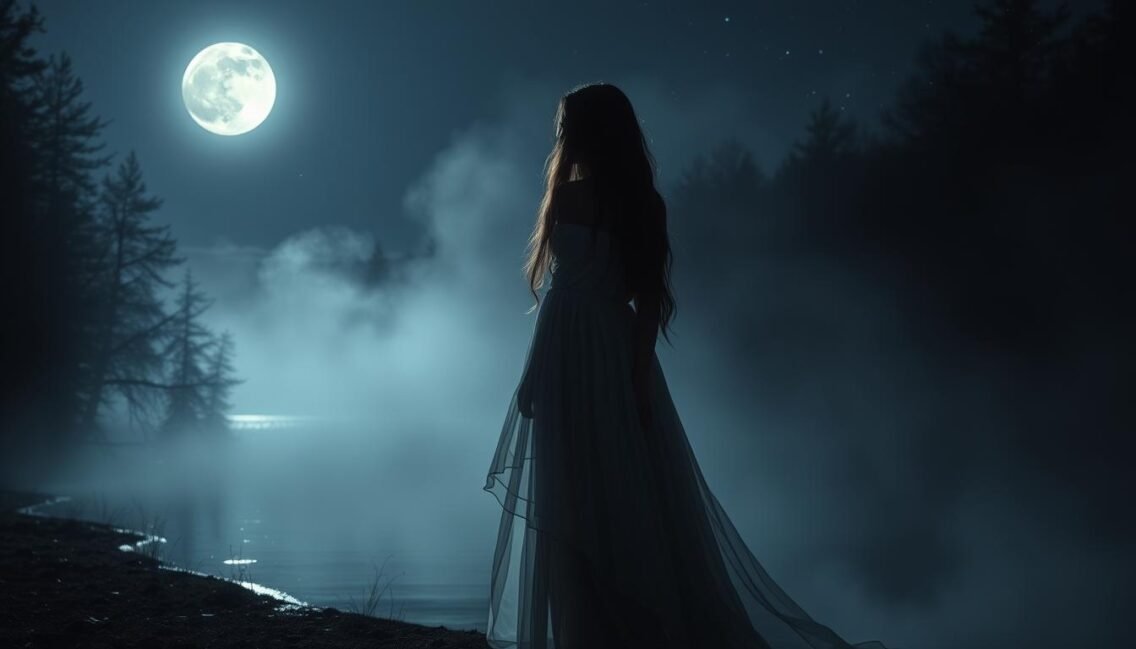La Llorona: The Weeping Woman Legend | Ancient Tales

I remember my abuela telling me about La Llorona, the “Weeping Woman” ghost. She haunted Mexico’s rivers and waterways. As a kid, I was both scared and fascinated by her legend.
La Llorona was once a beautiful woman. She drowned her children in anger and jealousy. Now, she’s trapped, searching for them and crying out in sorrow.
This old tale has been shared for generations. It has grown and changed, becoming a big part of Mexican culture. La Llorona’s story warns us about the dangers of our actions and the pain of guilt.
Key Takeaways
- The legend of La Llorona is a centuries-old Mexican folktale about a ghostly woman who drowned her own children and now wanders near water, weeping for their loss.
- The story has captivated audiences worldwide and is a significant part of Latin American culture.
- The legend has evolved over time, with pre-Hispanic, colonial, and modern interpretations all contributing to its enduring popularity.
- La Llorona represents themes of maternal betrayal, guilt, and the consequences of one’s actions.
- The legend continues to be a source of fascination and fear, with numerous sightings and eyewitness accounts reported throughout Mexico and beyond.
The Origins of Mexico’s Most Famous Ghost Story
The legend of La Llorona, or the Weeping Woman, is a big part of Mexico’s culture. It comes from ancient stories mixed with colonial-era changes. These stories have grown over time, drawing in people from all over.
Pre-Hispanic Influences on the Legend
The story of La Llorona started long ago, in the pre-Hispanic era. It’s based on Aztec and Mesoamerican folklore. The tale of a woman who drowned her kids and now searches for them is rooted in these ancient myths.
Colonial Period Adaptations
When the Spanish came, the story of La Llorona changed a lot. It was mixed with European folklore and Christian beliefs. This made the story even more special in Mexican culture.
Modern Interpretations
Today, La Llorona’s story still grabs people’s attention. It’s been told in movies, books, music, and more. These new versions dive deeper into themes like grief, being left out, and the lasting power of old tales.
La Llorona’s legend has lasted for centuries. It shows how old stories can shape a culture. From its ancient roots to today’s retellings, La Llorona’s story keeps haunting and captivating us all.
Who Was La Llorona: The Weeping Woman Legend
The legend of La Llorona, the weeping woman, is a key part of Mexican folklore. This ghost story has been fascinating people for generations. But who was La Llorona, and why does she haunt us?
La Llorona was once a young woman named Maria, living in colonial Mexico. She was filled with jealousy and anger when her husband left her for another woman. In a moment of madness, she drowned her children. Then, she drowned herself, forever trapped in a cycle of grief and guilt.
“She is said to appear at the edge of rivers and lakes, dressed in a long, white gown, her face obscured, weeping and calling out for her children. The sound of her sorrowful cries is believed to be an omen of misfortune or even death for those who hear them.”
The story of La Llorona varies slightly from place to place. Some say she was an indigenous woman, while others claim she was a mestiza or even a Spanish noblewoman. Yet, her tale remains a powerful reminder of the dangers of neglect and the lasting impact of grief.
The Tragic Tale of Maternal Betrayal
The legend of La Llorona, the weeping woman, is a heart-wrenching tale of love and betrayal. It has been told for centuries. At its core is a decision that changed a woman’s life and the lives of her children forever.
The Fatal Decision
In a moment of deep sadness, La Llorona made a choice that would haunt her. She drowned her children in the cursed river, believing it was to protect them from a hard life. This act of cruelty made her a tragic figure, forever doomed to cry by the river.
The River’s Curse
The river witnessed this terrible crime and was forever cursed. It became a dark place that haunted La Llorona. As she searched for her children, the river trapped her, keeping her in endless pain and sorrow.
The La Llorona legend warns of the dangers of the cursed river. It says anyone who gets too close will be pulled into its cold waters, joining La Llorona in her eternal punishment.
Eternal Punishment
La Llorona’s story is a reminder of the harm caused by maternal betrayal. She is doomed to wander the riverbanks forever, her cries a haunting reminder of love, despair, and the lasting effects of our choices. Her legend continues to captivate and frighten, a timeless warning that resonates through history.
Geographic Spread of the La Llorona Legend
The story of La Llorona, or the Weeping Woman, has fascinated people for centuries. It has spread across Latin America, adapting to different places while keeping its core story. This tale of a Mexican ghost has become a part of many cultures.
La Llorona’s story began with pre-Hispanic cultures. Over time, it mixed with Mexican ghost tales and Latin American folklore. As it moved, it changed, fitting into the stories of each new place it reached.
“La Llorona’s wails echo through the night, a haunting reminder of the enduring power of this timeless tale to capture the imagination of people across the Spanish-speaking world.”
In Mexico City and Andes villages, La Llorona’s legend connects different stories. It has grown, changing to fit local traditions but keeping its core themes. These include tragedy, loss, and the spirits that haunt us.
La Llorona’s legend shows the lasting impact of Mexican ghost stories and Latin American folklore. It crosses borders, touching hearts everywhere. The Weeping Woman reminds us of the cultural traditions that make Latin America so rich.
Common Sightings and Eyewitness Accounts
The legend of La Llorona, the weeping woman, has fascinated people in Mexico for many years. Her sad story has been told for generations. Yet, seeing her ghostly form still amazes and frightens those who encounter her.
River Bank Encounters
Many have seen La Llorona near rivers and streams. Her cries are heard at night. People say she’s a ghostly woman in white, with long, dark hair, searching for her children.
Midnight Apparitions
La Llorona is most active at midnight. Many have seen her then. Her ghostly wails are loud, making those who see her very scared.
Children’s Warnings
Children in Mexico are often told to beware of La Llorona. Many kids claim to have seen or heard her. This makes them very afraid of her.
La Llorona’s sightings shape Mexico’s culture. They remind us of the lasting power of old stories. These tales deeply affect the people’s collective mind.
Cultural Impact in Mexican Society
The legend of La Llorona, or the Weeping Woman, has deeply influenced Mexican culture. It has become a key part of Mexican folklore, affecting many aspects of life. This ghostly tale has been passed down for generations, shaping beliefs and practices.
La Llorona’s story warns parents to always watch over their children. It teaches the importance of family and the dangers of neglect. It also helps parents keep their kids in line, using the ghost as a reminder of the consequences of bad behavior.
“La Llorona’s wails echo through the night, a haunting reminder of the importance of cherishing our loved ones.”
The legend also shapes broader cultural beliefs in Mexico. La Llorona represents the outcomes of bad choices. Seeing her is believed to signal trouble ahead, influencing how people view the supernatural and the spiritual world.
La Llorona’s lasting impact on Mexican society is clear. She symbolizes family values, responsibility, and the effects of our actions. Her haunting presence continues to influence and captivate Mexicans, ensuring her story will live on for many years.
La Llorona in Popular Media and Entertainment
The story of La Llorona, the Weeping Woman, has been a hit for years. It’s no wonder it’s in many forms of media and entertainment. From scary movies to books and songs, La Llorona’s legend shows its lasting impact.
Film Adaptations
La Llorona has made a big splash in movies. The 2019 film “The Curse of La Llorona” is a great example. It’s set in 1970s Los Angeles and follows a social worker and her kids as they face the Weeping Woman.
Literary References
La Llorona has also inspired many writers. Books and stories have explored the legend, adding to its mystique. For example, “The Woman in the Wall” by Ana Castillo looks into the Weeping Woman’s impact on culture and psychology.
Musical Tributes
La Llorona’s haunting tale has also inspired musicians. Many songs, old and new, celebrate her eternal sorrow. These songs keep her legend alive, touching hearts across the globe.
La Llorona’s lasting appeal in media and entertainment is clear. Her story continues to captivate, from movies to books and songs. The Weeping Woman’s legend lives on, fascinating people everywhere.
Similar Weeping Woman Legends Worldwide
The story of La Llorona, the weeping woman of Mexico, is well-known. But it’s not the only legend of its kind. Around the world, there are similar tales of weeping female spirits. These global ghost stories and weeping woman myths often talk about maternal tragedy, supernatural vengeance, and eternal sorrow.
In Aztec mythology, there’s Cihuacoatl, the “snake woman.” Ireland has the Banshee. China’s White Lady of Zhangjiakou warns of coming disasters. And Japan’s Yuki-onna, or “snow woman,” freezes travelers to death.
“The weeping woman is a universal archetype, found in cultures around the world. She represents the ultimate maternal tragedy – a mother’s loss of her children, and the anguish that reverberates through the ages.”
These weeping woman legends often warn us about the dangers of our actions. They show the dark side of family and the bond between mothers and children. By looking at these global ghost stories together, we learn more about our shared human experiences.
The Psychology Behind the Legend
The story of La Llorona, the Weeping Woman, is both captivating and deeply psychological. It explores themes of maternal guilt, societal expectations, and the human psyche. This ghost story has fascinated people for many years.
Maternal Guilt Symbolism
At the core of La Llorona’s legend is a powerful symbol of maternal guilt. The tale revolves around a woman who, in a moment of rage and despair, drowns her children. This act of violence and regret symbolizes the deep pain and guilt that mothers can feel. It speaks to universal fears and emotions, touching people on a deep level.
Social Control Aspects
The La Llorona legend also serves as a tool for social control and moral teaching. The ghost’s eternal search for her children warns of the dangers of breaking societal rules. It shows how ghost stories can shape cultural values and enforce social norms.
The La Llorona legend continues to captivate us. It explores La Llorona symbolism and ghost story psychology in a way that speaks to us all. As we dive into this tale, we discover timeless truths that connect us across generations and cultures.
“The story of La Llorona taps into the deepest fears and anxieties of the human experience, revealing the complex interplay between the individual and the society in which they exist.”
Modern Day Significance and Interpretations
The legend of La Llorona still fascinates people today. It has grown to tackle big social issues and cultural concerns. Now, La Llorona stands for grief, injustice, and her role in our changing world.
Her story has been reimagined to reflect the struggles of different groups. It touches on motherhood, mental health, and the struggles of the marginalized. This way, La Llorona has become a symbol of our complex human experiences.
The legend reminds us of storytelling’s power to unite and challenge us. It encourages us to face today’s big issues. La Llorona’s story invites us to think about our relationships, society, and the universal human experiences.






Lucia
November 2, 2024i m live in mexico city. i might have seen this Lallorona. one time at Lake Xochimilco with friends, we were enjoying a walk when the fog rolled in, and everything went quiet. I walked to the edge of the boat and suddenly heard a soft, eerie wail. I turned and saw a woman in white, her hair covering her face, reaching out over the water. i was screamed and covered my face. when my friends came to me, we saw a black kind of water plants floating. i told them what I might have seen. well till know I don’t know what I saw.